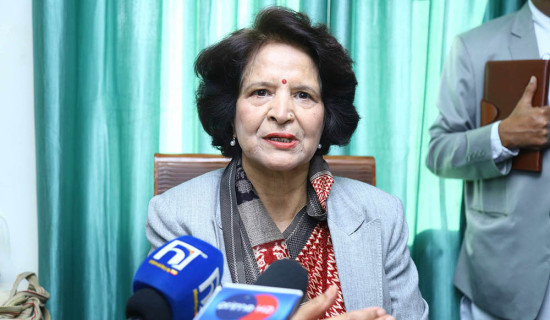- Friday, 26 December 2025
2023 second warmest year for Nepal after 1981
Kathmandu, Feb. 12: The year 2023 was the second warmest year for Nepal, according to the Department of Hydrology and Meteorology (DHM). Earlier, 1981 was the hottest year after DHM started keeping the temperature record in Nepal from 1962.
The average maximum temperature for Nepal in 2023 was 27.9 degrees Celsius, marking a slight increase of 0.6 degrees Celsius compared to the previous normal annual maximum temperature. Similarly, the average minimum temperature was at 15.6 degrees Celsius, indicating a 0.5 degrees Celsius rise from the normal annual minimum temperature, the DHM said.
According to the DHM, Okhaldhunga witnessed an increase of 1.6 degrees Celsius from 30.9 degrees Celsius on April 28, 1999 to 32.5 degrees Celsius on June 9, 2023.
Similarly, the temperature in the Birendrachowk station in Gorkha rose by 1.0 degrees Celsius, from 38.0 degrees Celsius on May 8, 2014, to 39.0 degrees Celsius on June 8, 2023. Additionally, there was a 1.0 degrees Celsius increase in temperature at the Kanyam Tea Station in Ilam, from 29.0 degrees Celsius on July 10, 1973, to 30.0 degrees Celsius on June 3, 2023.
The recent worldwide findings have also shown that global warming has exceeded by 1.5 degrees Celsius across an entire year for the first time, with January breaking new temperature records.
According to the European Copernicus Climate Change Service (C3S), the first month of 2024 was 1.66 degrees Celsius hotter, marking the warmest January and breaking yet another heat record after the troubling extremes of 2023.
And Nepal is no exception to this global temperature rise, said Ajay Dixit, an expert on issues of water, climate change and disasters.
“The warming trend is similar in Nepal as well. The impact of temperature rise is seen globally as the impact due to the absence of a transition to clean energy from coal fuel,” Dixit said.
According to him, the world has failed to implement the Paris Agreement made on November 4, 2016. The agreement aimed to hold ‘the increase in the global average temperature to well below 2 degrees Celsius above pre-industrial levels’ and pursue efforts ‘to limit the temperature increase to 1.5 degrees Celsius above pre-industrial levels.’
In Nepal, a sudden increase in maximum temperature by the end of May last year led to mild to severe heatwave conditions over large parts of the country which continued till the second week of June.
Dr. Binod Pokharel, Associate Professor at the Central Department of Hydrology and Meteorology at Tribhuvan University, said that the increase in warmer years indicated a rise in drought intensity. He highlighted that over the last decade, the frequency of droughts had also escalated in the country.
"There is a direct and indirect impact of temperature rise. The direct impact can be seen in the increase in forest fires. Warm years without rainfall may lead to an increase in forest fires, pollution, agriculture, and the drying up of springs, all of which are directly related to people's health and the ecosystem,” Dr. Pokharel said.
The DHM record shows that the regional temperature variations were significant, with the southern part of the country experiencing average maximum temperatures above 30 degrees Celsius while the northern part recorded temperatures below 18 degrees Celsius.
Bibhuti Pokharel, Chief of the Climate Section under the DHM, said that several parts of Nepal experienced hot days and heat wave conditions during different periods of the year. The heat wave was persistent over central and western parts of the country before the onset of monsoon over the region until the third week of June.
Specifically, the southern regions, particularly districts like Kapilvastu, Rupandehi and Chitwan faced mild to severe heat waves, with temperatures exceeding 42 degrees Celsius for several days.
Several meteorological stations broke previous records for extreme temperatures, highlighting the intensity of the heat waves experienced in 2023, the DHM said.
The year commenced with increased monthly maximum temperatures in the initial two months, followed by a period of below-normal maximum temperatures from March to May. June saw the highest deviation from normal temperatures, warmer by plus 2.0 degrees Celsius.
Subsequently, above-normal maximum temperatures persisted from June to December, except for August, which witnessed below-normal temperatures. Monthly minimum temperatures remained above normal throughout the year, except for April and May. Comparing annual average minimum temperatures since 1981, 2023 ranked as the second warmest year.
Rainfall pattern
According to DHM, Nepal received approximately 91.2 per cent of the normal precipitation, totalling around 1570.4 mm for the year. Notable variations were observed across different regions. The northern part of Karnali Province witnessed comparatively lower precipitation levels, with the Dunai station in Dolpa district recording 410.7 mm.
On the other hand, isolated areas of Gandaki Province experienced exceptionally high rainfall, with Lumle station in Kaski district recording the highest total precipitation of 4625.9 mm.
Discrepancies in precipitation levels were evident across various stations, with Khudibazaar recording the highest percentage of normal precipitation (129%) and Janakpur Airport station recording the lowest (51%).
The meteorological data for 2023 underscores the complex climate patterns observed in Nepal, with variations in precipitation and temperature levels across different regions, alongside significant instances of extreme weather events like heat waves.
According to Dr. Pokharel, “Now the country should focus on adaptation because there might be a trend of shifting farming systems. We have been witnessing a short winter season, high-intensity rainfall in a short span of time and winter drought,” he added.
















